Massage Ball/Lacrosse Ball
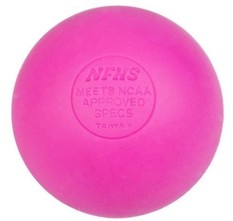
Resistance Bands
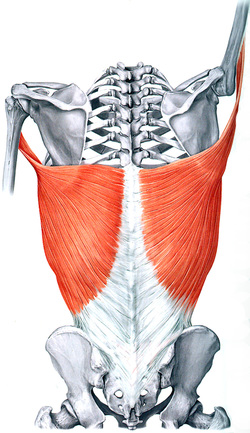 Those pesky lats
Those pesky lats 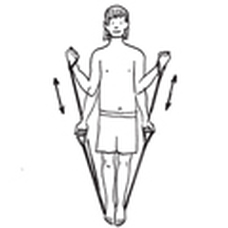
Washing Line
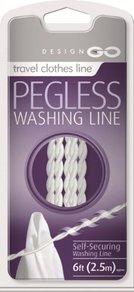
Vibram Five Fingers
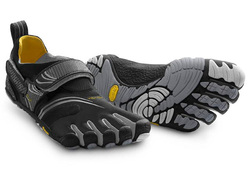
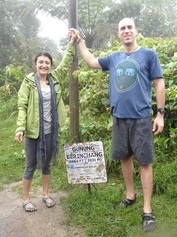 The Five Fingers at the top of
The Five Fingers at the top of Gunung Berinchang, Malaysia
Straightening Iron
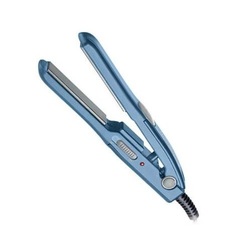
After a brief summer hiatus, we finally come to the conclusion of our Essential Travel Gear series! In our last two posts we’ve covered essential travel gear for keeping your money safe and the best electronics to take for world travel. Now it’s time to talk about the little things that make a big difference in the long run. When it comes to staying healthy and keeping clean, a few little pieces of gear can make all the difference. Let’s take a look inside our bags... Massage Ball/Lacrosse Ball  This might win the award for least expected, most amazing/useful gift received on our travels. When we first started out on our trip, we dropped by Columbus to visit our friends Nat & Rayn. We had a great time visiting food trucks and eating delicious meringues. Nat is a massage therapist and before we left he gave me a simple lacrosse ball. He said I could use it to work out knots on the road. OMG, was he right! This little ball has been our constant companion – you can roll your feet on it at the end of a hard day for instant relief, or put your back to a wall with the ball there to massage out knots in your lower or upper back. Calves cramping after a long day of walking? Rub the ball along the line where the shin meets the muscle and feel the aches melt away. Costing nearly nothing, this is a must have for any travelers! Thanks Nat! Resistance Bands Those pesky lats Those pesky lats As we traveled, yoga was our primary method for staying fit. After all, with yoga you only need a small space on the floor or ground to get a full body workout. But there are a couple muscle groups that even the most intense yoga workout leaves relatively untouched - mainly the biceps and the latissimus dorsi (back muscles). Typically you need equipment only found in a gym to work those muscles, which isn't available when hopping around the globe! By doing push-ups on the floor of your hotel, you can keep your pecs (chest) and triceps (the back of your arms) healthy and toned while traveling. But there is no easy way to work out your back and biceps. This is where the bands come in. To work both lats and biceps at one time, find a tree or a sturdy radiator in your room and wrap the band around it. Then grab each end, bend your knees slightly, and pull the band towards you. You want your elbows to scrape along your ribs and to pull your hands back to your ribs. This “rowing” motion will work both your biceps and your lats.  Alternatively, you can stand on the band and do bicep curls like the picture on the right. Simply spread your legs further apart to work the biceps more (though this movement will not work your back like the above movement). By doing this and push-ups regularly you would never know I hadn’t been to a gym in over two years! Resistance bands come in different lengths and levels of tension, but the ones we used are made by Fitness Gear (click here for the link). We particularly liked these resistance tubes because you don't need the handles, which are unnecessary when trying to pack ultra-lite. Just build up your wrist strength and grab the ends (like the in the picture above) without handles. I used the "heavy" band and Neda used the "light" band – they easily fit around the circumference of our Porter packs. Washing Line  When you’ve only got two days in a place to explore, I guarantee that you’re not going to want to sit and do laundry while time passes by. And if you are traveling ultralite, it often doesn’t make sense to pay to get a whole load done. So you end up washing a lot of shirts and underwear in the sink with a bar of soap. But what to do about drying? That is where a clothes line ends up making life a lot easier. Just a simple piece of thin rope can do, but I like a design like this GoTravel Pegless Washing Line. It has hooks on either end as well as suction cups that can attach to the hooks, giving you maximum versatility. We could put the hooks around an outside balcony and dry our clothes or if no balcony, suction the ends to the bathroom tiles. It’s a tiny, but very useful thing for long-term travelers especially! Vibram Five Fingers  I mentioned these shoes in a previous post, but they deserve one more glance. The Vibram Five Fingers are quite popular now as a “minimalist” running shoe. The sole is so thin that it is almost like walking barefoot, and supporters say that it strengthens muscles in your feet that regular shoes don’t and encourages correct form in walking and running. I don’t know about all that, but I do know that they weigh nearly nothing. Neda’s model was the Bikila Shoe, weighing in at 7.5oz and Jeff’s the Komodo Sport (pictured), which at nearly double the size, still weigh in at only 14.5oz! Compare that to an average athletic shoe and you are saving 1.5-2.5 pounds of weight!  The Five Fingers at the top of The Five Fingers at the top of Gunung Berinchang, Malaysia The shoes really shine in their versatility. Forget about heavy hiking boots – we used these to climb the highest peaks of New Zealand and trek through the thickly wooded jungles of the Cameron Highlands in Malaysia. We used them as water shoes for snorkeling (though they don’t recommend that) and of course as shoes for morning runs. Want to do yoga outside? These are a great solution. And when you think about all the things you can do with that extra 2lbs of weight, they really are a no-brainer for travelers. We loved our five fingers! Straightening Iron  From trekking through jungles to navigating through the humidity of India, it is hard to keep your hair looking good! One of Neda's favorite little tools was this mini straightening iron. It is so powerful, that she was able to straighten all of her hair with it and smooth the frizziness away! She knew she made the right choice, when she found out that fellow traveler and hair stylist, Shea, also wouldn't travel without her mini BaByliss PRO Nano. This tool is so small that it just fits on the side of the pack and doesn't take up any extra space or adds any weight. It is also dual voltage to be used worldwide with the appropriate adapters. That wraps up our series on essential travel gear for trotting the globe. Hope that this gear helps you on our journey and have a great trip!
2 Comments
Dim Sum’s roots lay buried in Southern China where the ancient tradition of tea tasting was popular. As the silk road grew more crowded with travelers and people discovered that tea aided in digestion, it made sense to offer some snacks with the tea. Lucky for us, those snacks were so delicious and varied, that the tradition stuck and Dim Sum was born. Literally meaning, “touch the heart”, I think the Chinese may have had some inkling of how unhealthy these little delectable morsels were when they came up with the name – if you’re not moderate they literally will touch your heart! But as we flew into Kuala Lumpur and got our first experiences of the city, we realized that the idea of dim sum really epitomizes the cultural smorgasbord found in the country. In addition to the indigenous Malay population, India and China have both been actively trading with the strategically located peninsula since around the 2nd century AD. By the 11th century Islam had spread across the country via trade and in the 16th century the Dutch established a strong presence, followed finally by the British in the 18th century. 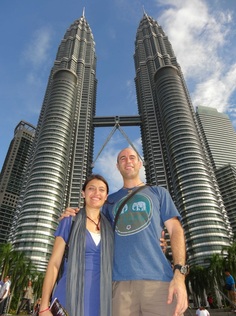 But the highlight of the city came in a pair. The Petronas Towers rise 1,500 meters in the air and seem almost like giant minarets visible from anywhere in the city. The towers are the home of the country’s national oil company, but also incorporate Islamic geometric principles as they rise in the shape of an eight-sided star. Under the towers sits an enormous mall while in their shadow is a large park with a wave pool - a playground for kids. All in all, it’s a wonderfully designed space, perhaps best appreciated from above. To do so, we headed to the nearby Trader’s Skybar, with views straight to the towers and attached park. As day turned to night, we watched the towers light up like shimmering crystals protesting the darkness. The sight of this architecture, turned into mesmerizing, incandescent sculpture as the night fell, was a true highlight. Add to that our first beer in 6 weeks (we didn’t drink while in India) and the night was complete! 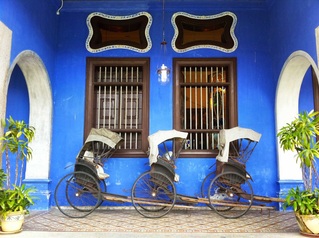 Cheong Fatt Tze Mansion After Kuala Lumpur we headed to the Cameron Highlands for adventures with tea (see our post about that here), before heading to the island of Penang, in the northwestern part of the peninsula. Penang’s history started to get really interesting in 1786 when the Sultan of Kedah ceded Penang to the British East India Company in an attempt to gain protection against Siam (though it didn’t work). The British established Penang and other small territories along the coast of Malaysia (called the “Straits Settlements”) to use them as free trade ports. As such, an enormous mixture of people combined there, making a veritable dim sum cart of cultures. There were the indigenous Malays, the Chinese (who had come in droves when tin was discovered in Malaysia), the Klings (southern Indians), and of course the Europeans. In addition, a new culture known as Pernakan was created out of the marriages of Malays and Chinese. 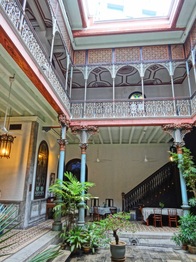 traditional atrium The mixture finds its apex in the delightful city of Georgetown on Penang. Old Chinese shop houses sit across Anglican churches (and a British fort) while Little India booms out music and the local Malays worship at the white-washed mosques. We stayed in a Chinese heritage house, formerly a shop house and family home all in one. It had a beautiful atrium in the middle - a necessity in Chinese Feng Shui, which believes that rain water must be able to enter the home as it symbolizes the coming of wealth. From there, we explored the city and island and its many gustatory delights. Each morning would find us participating in the ritual of dim sum, where a pot of loose leaf Chinese tea was served as women would cart around trays with little dishes of goodies you could choose. Some of our favorites were the deep fried pork rolls, the Chinese white bun stuffed with chicken, egg, and mushroom, and the crab and sesame seed topped dumplings! When we were sated on meat, the city also had a variety of economical vegetarian buffets, where you could fill up your plate with healthy greens and delightful tofu dishes for just a few dollars. 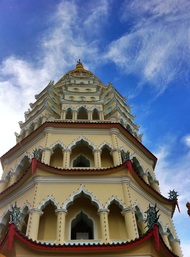 Pagoda of 10k Buddhas After our big breakfasts, we would do some sightseeing before retreating back to our wonderful room for a respite from the smothering heat. The one day we rented a motorbike and braved the heat, however, we did manage to see many of the sites outside of Georgetown. This included Wat Chayamangkalaram, a massive Thai temple with a huge reclining Buddha inside, and Kek Lok Si Temple, the largest Buddhist temple in all of Malaysia. Kek Lok Si sports a massive statue of Kuan Yin (the bodhisattva of compassion) as well as the towering Pagoda of Ten Thousand Buddhas, which was designed in Chinese, Thai, and Burmese styles to represent the unity of the different types of Buddhism. Perhaps most unique however, was Ban Kah Lan, or the snake temple, where many years ago monks had allowed the local venomous Wagler’s pit vipers to live on the grounds rather than kill them. Over time, this developed as the temple’s primary attraction and a visit sees the vipers not only on branches curving next to the altar, but resting on branches all over the trees behind the temple. Be warned that it’s good to visit during the day when the vipers are sleeping – a trip at night may be your last! The Chinese architecture in Georgetown was impressive as well. The Cheong Fatt Tze Mansion showed the opulence enjoyed by one of China’s richest businessmen at the turn of the 20th century. Nearby, the Khoo Kongsi temple and other clan temples have intricate carvings and statues meant to honor the clans of the immigrants who had moved there. We also happened to be in Penang over the Christmas holiday and the friendliness of the locals was matched by the friendliness of the local Couchsurfing Community. Brian and Magda, a wonderful couple from Canada and Poland respectively, decided to host a Christmas Eve potluck for couchsurfers in the area. The evening was full of fun and conversation as we had travelers from Hungary, India, Romania, Spain, and locals all mixing to share food and experiences. The next day we all met up again for an Indian Christmas dinner and drinks. All in all, we loved our time in Malaysia as we got to choose all the goodies we wanted from our dim sum cart - good people, good food, and great cultural variety. Now we are in New Zealand, but on the way here we had an 11 hour layover on the Gold Coast of Australia. So why not hit the beach? We threw our bags in a locker, changed into our swimsuits and a 10 minute bus ride later we were having a great time riding the waves in the beautiful azure green water. Our updates for New Zealand will be sporadic at best as we cruise our Toyota Estima with a futon in the back around the two islands! We hope to wrap up the purchase of the van in a couple days and in the meantime had a great New Year's Eve out on a beach house of our friends Chris and Lauren, who we have re-united with for the next week or so! You might remember them from Cambodia and Vietnam!
Bodhidharma felt his eyelids drooping and his body tilting forward as sleep encroached yet again onto his meditation. He stiffened his back and resolved his will. “You must go beyond all words into the deepest truth there is. You must continue beyond selfhood and otherness into the realm where black and white fade away.” For seven years he had sat in this cave, a stone’s throw from the Shaolin Temple which had refused him entry. He had decided that this spot was as good as any other for the contemplation needed. But this damned sleep kept interrupting his quest, calling him to lie down and take a rest. He caught himself slumping forward again, this time his forehead nearly knocked into the unyielding stone before he caught himself and returned upright. 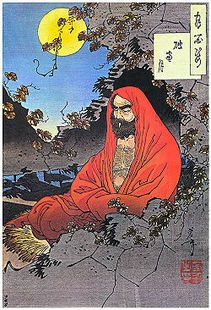 Bodhidharma “Something must be done!” he roared inwardly to himself and made his decision. He reached up and with each thumb and forefinger gripped the eyelids that had been failing him for the past seven years. As felt his bushy beard on his forearms and the soft flesh of his fingertips, he gave a merciless tug. The lids came off in his vice-like grip and he threw them to the ground, able to now continue with his meditation unhindered. Two years later, the Shaolin monks came to the cave to see if Bodhidharma still practiced there. They discovered no sign of the founder of the Zen lineage of Buddhism, except for two peculiar plants growing side by side on the ground near the wall of the cave. The leaves were a luscious green and their smooth curves were reminiscent of eyelids. These were the first tea plants. Or so the legends tell us! Bodhidharma’s eyelids (the tea leaves) were to be the fuel for generations of Chan (Chinese Zen) monks' meditation - helping them to stay awake during their practice. In actuality, tea has been around in China since at least the 10th century B.C., though it would take thousands of years before its commercial cultivation would find its way to Malaysia, the next stop on our world tour. After flying from Kolkata to Kuala Lumpur (we’ll blog about this city later, but FYI everything we'll do in Malaysia is on the eastern peninsula above, we didn't have time for the western part), Neda and I took the winding road up to the biggest hill station in the country – the Cameron Highlands. Developed in the 1930’s as a way for the British to escape the scorching lowland heat, an entrepreneur named J.A. Russell realized that it was also an ideal environment for growing tea. He bought a tract of land in the area and named his plantation Boh (Malaysian for “high”). Having missed the tea plantations in Darjeeling due to the cold weather there, Neda and I were excited to visit Boh and see the cultivation of one of our favorite beverages. 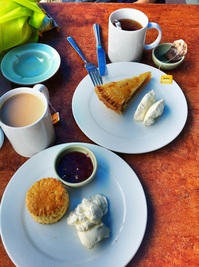 Our first day in Cameron, we met up with a Polish blueberry farmer turned off-season backpacker named Mat. He gave us some tips on a hike he had just done in the area and invited us to join him on a longer trek up to the tallest peak in the highlands, Gunung Brinchang. (Logistical Note: Mr. Yen in the Cameronian Inn gave Mat and us great tips on the hiking in the region and has drawn accurate and up to date maps as well). Our first trek, up to the top of Gunung Jasar, was presided over with blue skies and clear views of the village below as well as the cottage where Jim Thompson, the former CIA agent who helped revitalize the Thai silk business, was last seen before disappearing in these highlands one sunny day in 1967. The afternoon found us sampling the teas of the region while digging into homemade scones with strawberry jam and apple pie with a dollop of fresh cream. We felt quite aristocratic! 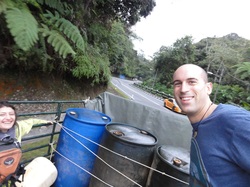 hitchhiking! The next day we set off early with Mat for our trek up Gunung Brinchang. The trek started from the next town over so we began the journey by hitchhiking on the back of a pick-up truck into town. This time around the sky was already darkening and droplets of rain foreshadowed the hike to come! But rather than detract from the experience, the weather added to it. The climb through the lush jungle as the rain splattered on the leaves was as atmospheric as it gets. Despite the mud and wetness, we were in high spirits as we emerged at the top, with a view only of the settled mist of the clouds we had entered as we climbed. Down a ways from the peak we walked on the more sterile boardwalk of the “mossy forest,” a tourist attraction that cleanly takes tourists through the views we had just seen but without the muddy shoes. Still, it made for some nice photos! 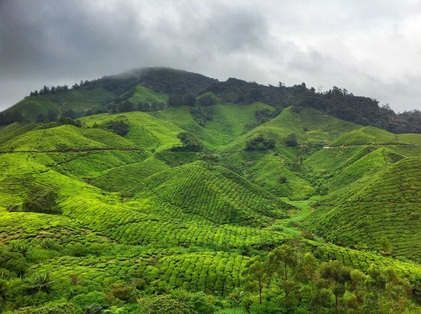 The road down the mountain led to the part of the trip Neda and I were anticipating the most. The tea! As we hitchhiked for the 2nd time down to the tea plantation, we admired the sprawling hills lined with the ordered plantings of the bright green tea. Finally, we arrived at the Boh visitor center, where after our long morning, the Palas Supreme whole leaf tea tasted just sublime. Neda swore it gave her a euphoric buzz, which the folks at Boh had long ago marketed when they said their tea had “uuummmph”! A walk through the tea processing plant also showed us how tea is picked, rolled to release its juices, oxidized (to turn it from green to black), and then dried for packaging. We left the plantation and after a short walk, took one last trip as hitchhikers back to Tanah Rata, the town where we started. 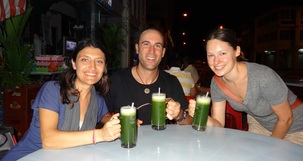 It was a successful trip up to the highlands and we enjoyed Mat’s company so much that we decided to go together to Ipoh, a nearby city that one of the guys who picked us up while hitchhiking lived in. He invited us there to show us some of the local cuisine. For this part of the adventure we added another traveler to our group, Kim from Seattle. Here's a picture of Kim and us with some fresh squeezed cucumber juice that looks sort of like a witches brew. Anyway, off we went to Ipoh to see what awaited! 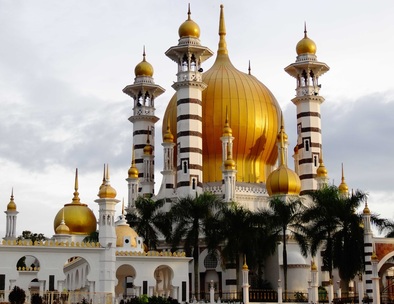 Well, it wasn’t exactly what we expected, that’s for sure. Our local contact never called us back, but that didn’t stop us from finding fun. First, we took a local bus out to the Malaysian Royal town of Kuala Kangsar, where we enjoyed the beautiful combination of British and Moorish architecture at Masjid Ubudiah (see right). That’s also where I got some delicious Nasi Lamak, a Malaysian dish of coconut rice with peanuts and a chicken leg in a sumptuous sauce. But once we arrived back in Ipoh, I was still hankering for the local dish of Ipoh sar hor fun (flat rice noodles cooked in chicken and prawn broth with chicken shreds, prawns and spring onions). It took us a bit out of the way to find it, but in doing so we stumbled upon a group of Indian Christians who were caroling in preparation for Christmas. Their Santa Claus had some sweet moves and a mean rhythm to accompany the tambourines and enthusiastically costumed kids. They even succeeded in getting Jeff into the action. You probably never expected to see a Buddhist-Jew dancing with an Indian Santa Claus while singing Christmas Carols, huh? See the video here! After a year full of adventures galore, we are approaching the end of 2012. Neda and I are going to head off to a Couchsurfing potluck in Panang in a few minutes to hang out with travelers from all over the world to celebrate Christmas Eve under the sweltering Malaysian heat! We wish you and yours all the best this holiday season and thank you for following along on our blog. Your comments and e-mails have been wonderful gifts to us all year long! Merry Christmas and a belated Happy Hanukkah! See all the pics of the Cameron Highlands, Ipoh, and Kuala Kangsar here!
http://flic.kr/s/aHsjDhnM3u |